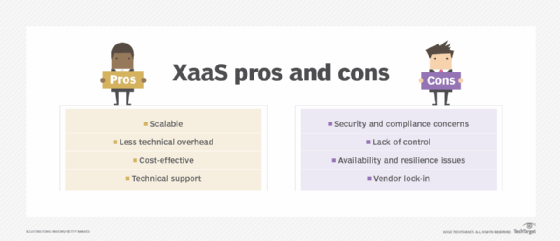What is XaaS (anything as a service)?
XaaS is a collective term that refers to the delivery of anything as a service. It encompasses the many products, tools and technologies that vendors deliver to users as a service over a network — typically, the internet — as an alternative to providing them locally or on-site to an enterprise.
This umbrella term refers to service offerings that are accessed as needed and financed using a pay-as-you-go cloud computing pricing model. XaaS offerings can scale up or down as needed with IT services delivered on demand by a managed service provider.
XaaS vs. SaaS
Software as a service (SaaS) is an early example of the as-a-service delivery model. SaaS and XaaS both refer to the delivery of a cloud service. Here’s how they compare:
- XaaS is the more general term. There are many different types of XaaS deployment models. The three main ones are SaaS, platform as a service (PaaS) and infrastructure as a service (IaaS).
- SaaS is a cloud-based software distribution model in which a cloud provider hosts applications and provides them to users over the internet as a service. It is one of the three main cloud computing deployment models and a commonly referenced one. There are many types of XaaS.
Examples of XaaS
The most common examples of XaaS are the following three:
- SaaS includes a range of applications, such as Google Apps, Microsoft Office 365 and Salesforce.
- PaaS providers deliver hardware and software tools to users over the internet. PaaS offerings, such as Amazon Web Services (AWS) Elastic Beanstalk, Apache Stratos, Google App Engine and Salesforce’s Heroku and Salesforce Platform, typically provide preconfigured virtual machines and other resources for application development and testing.
- IaaS is a model where a cloud provider provides IT infrastructure, such as storage, server and networking resources, over the internet to customers on a subscription basis . Examples of IaaS offerings include AWS Elastic Compute Cloud, Google Compute Engine and Microsoft Azure.
There are many other examples of XaaS, such as the following:
- Authentication as a service, or AaaS, uses cloud services for identity and access management.
- Containers as a service, or CaaS, enables the deployment and management of containers using container-based virtualization.
- Database as a service, or DBaaS, provides access to database platforms through the cloud. Public cloud providers like AWS and Azure have DBaaS offerings.
- Device as a service, or DaaS, is when a third-party vendor offers PCs, smartphones and other mobile computing devices as a paid service.
- Disaster recovery as a service, or DRaaS, enables cloud providers to help organizations regain functionality after a disaster.
- Function as a service, or FaaS, enables cloud customers to develop applications, deploy functionalities and only be charged when the functionality executes.
- Malware as a service, or MaaS, is a type of security SaaS delivered over the public cloud to help organizations guard against ransomware and distributed denial-of-service VMware AppDefense is an example of MaaS.
- Network as a service, or NaaS, is hosted network infrastructure provided by a third party.
- Storage as a service, or STaaS, provides application, data and backup storage systems in the cloud.
- Unified communications as a service, or UCaaS, is hosted software that supports synchronous and asynchronous communication from any device. UCaaS facilitates team collaboration.
Benefits of XaaS
Some of the main benefits of XaaS are the following:
- Cost-effective. Cloud service models cut costs and simplify IT deployments. Organizations cut back on their IT infrastructure, using fewer servers, hard drives, network switches and software deployments in their data centers.
- Less physical overhead. Services mean less physical overhead, such as space, power and cooling. This translates to reductions in IT staff and enables IT to focus on more important projects and business processes to provide a better customer experience. Additionally, the use of outside services rather than deploying on-premises technology shifts many capital expenditures to operational expenditures.
- Technical support. With XaaS, the third-party provider’s staff provision, maintain, upgrade and troubleshoot the service. As a result, customers can reduce their own on-premises support personnel.
- Scalability. Services can scale up or down depending on business needs.

Challenges of XaaS
XaaS business concerns and challenges include the following:
- Resilience and internet reliability. Customers depend on the XaaS provider’s infrastructure; disruptions in service are a potential issue.
- Visibility. Customers have limited visibility into and control over the service provider’s environment and infrastructure.
- Vendor lock-in and dependence. Customers depend on the service provider to provide consistent service. However, providers can go out of business, be acquired, discontinue a service or alter its features at any time.
- Security. If a provider experiences a security breach, the user’s data is put at risk.
- Hidden fees. Despite the convenience of the pay-as-you-go model, XaaS users can incur hidden or unexpected costs when working with a cloud provider.
The future market for XaaS
The combination of cloud computing and ubiquitous, high-bandwidth, global internet access bodes well for XaaS growth. Signs from vendors and researchers point to XaaS going mainstream as a business model as customers bring more workloads into the cloud.
The XaaS market is projected to grow to $2.4 trillion in 2029 from $437 billion in 2021, according to a Fortune Business Insights report.
Some organizations hesitate to adopt XaaS because of security, compliance and governance concerns. However, service providers are increasingly addressing these issues.
The convergence of 5G — and, in the future, 6G — edge computing, big data, artificial intelligence, automation, machine learning and the internet of things have contributed to the move to the XaaS model and the cloud in general. As businesses need to process more information, it becomes less economically feasible to host computing services on premises. This has led businesses, in many industry sectors, to incorporate the cloud as part of their digital transformation.
One type of XaaS that has grown in recent years is DRaaS. Learn about tips for outsourcing disaster recovery and business resilience capabilities.











